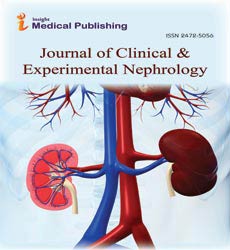Outcomes of Renal Transplantation and Different Medicare Stages of Renal Disease Program
Little Combes*
Department of Anatomy and Neuroscience, University of Melbourne, Victoria, Australia
- *Corresponding Author:
- Little Combes
Department of Anatomy and Neuroscience, University of Melbourne, Victoria,
Australia;
E-mail: combes.little@mcri.edu.au
Received: February 18, 2022, Manuscript No. IPJCEN-22-11496; Editor assigned: February 21, 2022, PreQC No. IPJCEN-2211496 (PQ); Reviewed: March 07, 2022, QC No. IPJCEN-22-11496; Revised: March 11, 2022, Manuscript No. IPJCEN-22-11496 (R); Published: March 18, 2022, Invoice No. IPJCEN-22-11496
Citation: Combes L (2022) Outcomes of Renal Transplantation and Different Medicare Stages of Renal Disease Program. J Clin Exp Nephrol Vol:7 No:1
Editorial
The Medicare end-stage renal sickness program has gotten impressive consideration as a model of government financing for significant expense clinical therapy. This paper inspects how the program has been affected by renal transplantation.
In the previous decade, the quantity of kidney transplantations has expanded generously, and the achievement pace of these strategies has improved. From 1980 to 1985, the quantity of transplantations expanded by 10% each year. During that time, the endurance rates for joins from dead bodies and living related givers expanded by 7 and 3 percent, individually, to some extent as a result of the presentation of cyclosporine. Thus, the quickest developing gathering of recipients of the Medicare end-stage renal illness program is those with working unions. As of the finish of 1985, these patients represented 18% of all recipients and 32 percent of all recipients under 55 years old. In the most youthful gatherings, transplantation has arrived at a level adequate to lessen the outright quantities of patients on dialysis, starting in 1983. Expansions in transplantation are not uniformly circulated among subgroups of recipients. Moderately couple of patients 65 years old and more established gets transfers; blacks get transfers at a rate generally a large portion of that among whites, however the rate is expanding.
Since the expenses of keeping up with patients with working unions are just a single third of those for patients on dialysis and in light of the fact that the personal satisfaction is generally much better, renal transplantation is causing an assembly of the best clinical and financial results for patients with end-stage renal illness.
Since the primary fruitful transfer of a kidney starting with one twin then onto the next in 1954, renal transplantation has moved from being at the forefront to being an adult innovation. Library information show that the current endurance rates for unites from bodies are around 88% and 60% at one and 10 years after transplantation, individually, while practically identical rates for joins from living benefactors are in overabundance of 95% and 70%. These rates have shown consistent enhancements in the course of recent years, with the one year endurance rates for unites from corpses and living givers improving by around 5% in that time. 13 One year patient endurance after transplantation is consistent at 95%, with 87% alive at five years. In the medium term (one to three years) after transplantation, clinical results are presently entirely acceptable, to the point that it is hard to work on the endurance of the patients or the unions. Dismissal rates have fallen throughout the long term, and dismissal is currently a phenomenal reason for early loss of a join.
Significant issues that currently should be settled incorporate the insufficient inventory of contributor organs, the result s o f treatment, the pestilence of cardiovascular illness in patients who have gotten renal transfers, and value of admittan ce to transplantation. This paper examines the new advancement i n the field of renal transplantation and thinks about what work is expected to handle the recent concerns confrontingc transfer trained professionals.
There has been an expansion in the transplantation of kidneys from living, hereditarily inconsequential givers and f rom broadened standards body contributors. The previous strategies about paid renal givers are being reevaluated. Strategies have been created to decrease dismalness for the living renal benefactor. The assortment of immunosuppressants permits individuation of treatment. Rules for origination and pregnanc y have been set up.
Cardiovascular sicknesses are generally prescient of who gets a transfer; patients with coronary illness, congestive cardiovascular breakdown, or left ventricular hypertrophy showed lower transplantation rates comparative with patients without the infection (relative rate [RR]=0.65 to 0.80, P<.05 each). Corpulent patients and patients with fringe vascular infection additionally showed lower transplantation rates (RR=0.65 to 0.75, P<.05 each). Recently detailed sociodemographic impacts of lower transplantation rates for more established patients, ladies, nonwhite patients, and lower pay patients were affirmed (P<.01). Sociodemographic impacts remained basically unaltered when adapted to comorbid conditions. Monetary pay in return for live kidney gift is disallowed in Canada. Nonetheless, patients in Canada with endstage renal infection and without an appropriate organically or sincerely related live contributor face considerable sitting tight occasions on records for expired benefactor kidneys, thus may accordingly decide to obtain organs from a live giver in a technique performed outside Canada as a component of a business exchange.
Open Access Journals
- Aquaculture & Veterinary Science
- Chemistry & Chemical Sciences
- Clinical Sciences
- Engineering
- General Science
- Genetics & Molecular Biology
- Health Care & Nursing
- Immunology & Microbiology
- Materials Science
- Mathematics & Physics
- Medical Sciences
- Neurology & Psychiatry
- Oncology & Cancer Science
- Pharmaceutical Sciences
